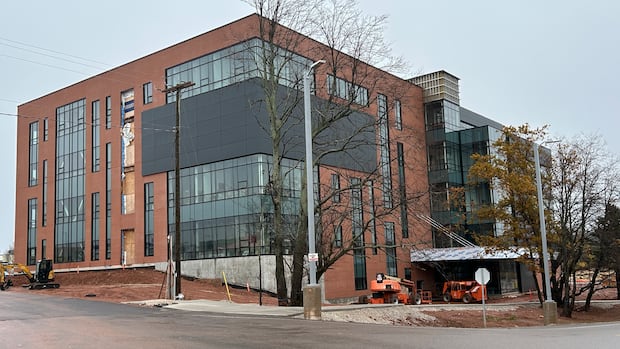Science
UPEI Launches Innovative Medical Simulation Centre for Future Doctors

The University of Prince Edward Island (UPEI) has unveiled its new Clinical Learning and Simulation Centre (CLSC), a state-of-the-art facility designed to enhance medical education through realistic training scenarios. This initiative aims to better prepare future healthcare professionals by simulating real-life medical situations, giving students the opportunity to practice before treating actual patients.
Catherine O’Brien, a seasoned actor and director, plays a pivotal role as a standardized patient at the CLSC. Her involvement began years ago with a program at the University of Toronto, where individuals portrayed patients to assist in medical training. Now, at UPEI, she brings her expertise to help students refine their interviewing and empathetic skills. “They will learn how to interview, how to ask the right questions, how to make the patient feel comfortable using empathy,” O’Brien explained during a recent CBC broadcast from the UPEI campus.
The CLSC offers a wide range of training tools, including high-fidelity manikins that can simulate various medical conditions. Paul Charles, the centre’s simulation program manager, emphasized the importance of creating realistic environments for students. “We recreate the simulation rooms like clinical hospital rooms with medication carts and vital machines, as well as manikins that can breathe, talk, and exhibit symptoms like heart attacks and seizures,” Charles stated. This approach aims to bridge the gap between classroom learning and practical application, ultimately enhancing student confidence and competence.
The centre’s offerings extend beyond students; healthcare professionals can also utilize the facility’s resources to sharpen their skills. Tammie Muise, the centre’s director, noted an innovative addition to their training program—a “simulation rig.” This trailer, designed to mimic the interior of an ambulance, allows health professionals to practice responding to critical situations like strokes or heart attacks in a controlled environment. “They can really fine-tune those skills to help improve patient outcomes,” Muise explained.
O’Brien has already interacted with the first cohort of students at UPEI’s medical school, expressing enthusiasm for the upcoming training sessions. “I have a few coming up, which I’m excited to get going with,” she said.
The CLSC represents a significant step forward in medical education at UPEI, providing an interactive and supportive environment where students can gain essential skills. By incorporating realistic simulations into their training, the university is setting a new standard for healthcare education in the region.
-

 Science3 months ago
Science3 months agoToyoake City Proposes Daily Two-Hour Smartphone Use Limit
-

 Health4 months ago
Health4 months agoB.C. Review Reveals Urgent Need for Rare-Disease Drug Reforms
-

 Top Stories4 months ago
Top Stories4 months agoPedestrian Fatally Injured in Esquimalt Collision on August 14
-

 Technology3 months ago
Technology3 months agoDark Adventure Game “Bye Sweet Carole” Set for October Release
-

 World3 months ago
World3 months agoJimmy Lai’s Defense Challenges Charges Under National Security Law
-

 Lifestyle4 months ago
Lifestyle4 months agoVictoria’s Pop-Up Shop Shines Light on B.C.’s Wolf Cull
-

 Technology3 months ago
Technology3 months agoKonami Revives Iconic Metal Gear Solid Delta Ahead of Release
-

 Technology3 months ago
Technology3 months agoApple Expands Self-Service Repair Program to Canada
-

 Technology3 months ago
Technology3 months agoSnapmaker U1 Color 3D Printer Redefines Speed and Sustainability
-

 Technology3 months ago
Technology3 months agoAION Folding Knife: Redefining EDC Design with Premium Materials
-

 Technology4 months ago
Technology4 months agoSolve Today’s Wordle Challenge: Hints and Answer for August 19
-

 Business4 months ago
Business4 months agoGordon Murray Automotive Unveils S1 LM and Le Mans GTR at Monterey









